Southeastern Massachusetts
-
- A Favorable Fetch for US Offshore Wind Marine News, Apr 2021 #24
Offshore wind caught a favorable gust with the 2020 election of Joe Biden, and the following breeze from the early 2021 reconfiguration of the U.S. Senate toward Democrats. Though widely touted as a growth engine for maritime businesses (as well as shoreside trades), the latter years of the Trump administration seemed to see delay after delay.
The class society DNV has been involved in offshore wind since its outset in the early 1990s, and now has 2,000 energy experts working in its efforts supporting this power source. Its business development manager, Nick Prokopuk, described the North American situation as being one of “revolution, not evolution” in a presentation at the recent Greek/Norwegian Chambers of Commerce virtual Shipping Conference, saying that “the growth forecast is exponential.” He explained that the coming decade will give rise to a huge demand for vessel construction for installation, service/maintenance, crew transport and guard duties. Speaking about the possible future of installed capacity, he said “the U.S. is looking to surpass what Europe accomplished over 30 years in the next nine to 10 years.”
The business is complicated; individual states—many with major decarbonization initiatives—deal with power purchases, but going forward the actual electricity will be generated from lease sites in federal waters (more than three miles offshore), and therefore subject to processes commanded from Washington, D.C. On the shore, building new supply infrastructures requires planning; yet, historically, inter-port coordination, if any, has varied state by state. Thus, new paradigms are emerging in the U.S. Capitol, at deployments offshore and within individual states.
On Capitol Hill, consider the Vineyard Wind project set to produce 800 megawatts (MW) in its first phase deploying 84 turbines, a joint venture between a wind-solar unit in Avangrid (a NYSE-listed producer of energy), and Copenhagen Infrastructure Partners (an investment fund manager specializing in renewable energy). The installation, off the coast of Martha’s Vineyard, Mass., was set to be the first major offshore wind farm in the U.S., selling electricity to a group of Massachusetts utility with a 2023 start date. The project was slowed down in early 2020 after offshore fishermen raised concerns about its layout interfering with their routes, and the Bureau of Ocean Energy Management (BOEM), the regulator of offshore energy deployments, delayed its permitting process. Late 2020 saw further delays, as Vineyard Wind sought to halt its permitting process (while reorganizing its footprint with larger turbines, only 62 required in Phase 1), and was greeted with an uncooperative BOEM.
What a difference a fortnight makes. Amid a flurry of Executive Orders from the new Biden Administration, offshore wind was mentioned. A White House summary of action from late January, says, “The order directs the Secretary of the Interior to pause on entering into new oil and natural gas leases on public lands or offshore waters to the extent possible, launch a rigorous review of all existing leasing and permitting practices related to fossil fuel development on public lands and waters, and identify steps that can be taken to double renewable energy production from offshore wind by 2030.” In early February, two weeks after President Biden’s inauguration, with a new director at the helm of BOEM (part of the Department of the Interior), the agency announced that Vineyard Wind’s application was back in the review process. The new Director, Amanda Lefton, who comes from a top energy job in New York State’s executive branch, said, in a statement, “BOEM is committed to conducting a robust and timely review of the proposed project.”
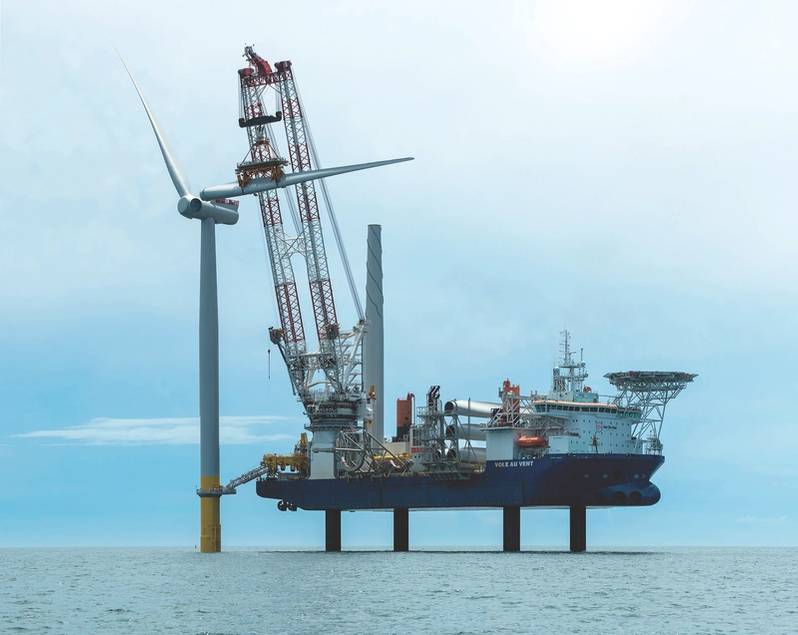 Coastal Virginia Offshore Wind (CVOW) turbine installation (Photo: Dominion Energy)
Coastal Virginia Offshore Wind (CVOW) turbine installation (Photo: Dominion Energy)On the legislative front, there were rumblings that The Ocean-based Climate Solutions Act (HR 8632. 116th Congress), a bill that failed to gain traction after its introduction just prior to the 2020 elections, could be reintroduced in the House of Representatives in 2021. The bill’s wording included a nonbinding “Sense of Congress” resolution pointing toward deployment of 30 gigawatts (GW) of electricity from offshore wind by 2030.
The U.S. maritime industry is set to mobilize for the widely anticipated boom. Michael G. Roberts, senior vice president at Jacksonville, Fla.-based Crowley Maritime, testifying at the U.S. House of Representatives’ Coast Guard and Maritime Subcommittee’s mid -February, 2021 hearings on behalf of the American Maritime Partnership (AMP), where he serves as president, described “as what may be a generational opportunity…” for the U.S. maritime industry.
Language in the National Defense Authorization Act (NDAA) for fiscal 2021, passed at the end of 2020, clarified that the Jones Act, an integral feature of the offshore oil patch in the Gulf of Mexico, would be applied analogously to offshore wind. The New Orleans-based Offshore Marine Service Association (OMSA), representing 170 companies, plays a critical role behind the scenes around Capitol Hill. Following the passage of the NDAA, OMSA’s president, Aaron Smith, said, “We are immensely grateful that Congress has passed legislation ensuring that all U.S. laws apply to offshore wind development and providing parity between offshore oil and gas projects and offshore wind projects.” Early efforts offshore Rhode Island and Virginia may offer the initial paradigm for U.S. turbine assembly, where non-U.S. flagged and non-mobile installation vessels handle assembly of components that are ferried out from the shore in Jones Act suitable tonnage. All manner of offshore service could be handled by U.S. based vessels.
In the individual states, the “renewables” catch-phrase also applies to the reinvention of port facilities—now for a new use. The waterfront and port communities all along the U.S. East Coast stand to gain, and huge investments in landside infrastructure, with hefty employment and spending, are also anticipated, pegged by Crowley’s Roberts in his February 2021 U.S. House testimony as “tens of thousands of jobs, tens of billions of dollars in economic output” with ancillary benefit of “play[ing] a significant role in decarbonizing electricity production in the United States.” In early February, Crowley announced a partnership with terminals specialist Watco (a holding of Oaktree Capital, a leading private equity investor, with a maritime presence), to bring a turnkey offering to “…owners, operators and local port authorities in support of the offshore wind industry.” In March, Crowley announced it is teaming up with Danish shipping company ESVAGT to build and operate purpose-built, Jones Act vessels to support the emerging U.S. offshore wind market.
Reinvention is visible up and down the coast. In conjunction with a New York State Energy Research and Development Authority (NYSERDA) procurement award to Equinor (partnered with energy major BP) for two windfarms, the state will earmark $200 million to fund two ports facilities, a one-time container terminal in Brooklyn that would be a staging and maintenance area, and another up the Hudson River in Albany, where towers would be manufactured. The private sector, including offshore project developers, will kick in comparable amount. Plans are in the works for other port projects along the Hudson River and in Long Island Sound, including Port Jefferson, N.Y., once an active shipbuilding center. In Fall River, Mass., the Vineyard Wind project was funding a study of redeveloping the city’s waterfront, while nearby New Bedford had booked leases at an old terminal from Vineyard Wind and Mayflower Wind (an 800 MW project south of Nantucket). In Connecticut, the State Port Authority agreed in early 2020 on a deal that would see a $157 million public/private redevelopment of the State Pier at New London, which handled lumber and general cargo, into an offshore wind staging area supported by a long-term lease from Ørsted. The Danish developer, along with a steel fabricator, has also committed to a major investment for building monopiles (the foundation for the towers) at an old oil terminal later repurposed for the imported steel trades which waned due to tariffs, in Paulsboro, N.J. Further down along the Delware River, an assembly area is planned. In Virginia, an underused container yard, Portsmouth Marine Terminal, has been repurposed as a staging area for Dominion Energy’s massive Coastal Virginia Offshore Wind (CVOW) project, with Ørsted working in conjunction with the state leasing dock space in advance of its 12 MW demonstration project deployed in Summer 2020. Maryland and Rhode Island have seen similar arrangements, with old facilities being repurposed.
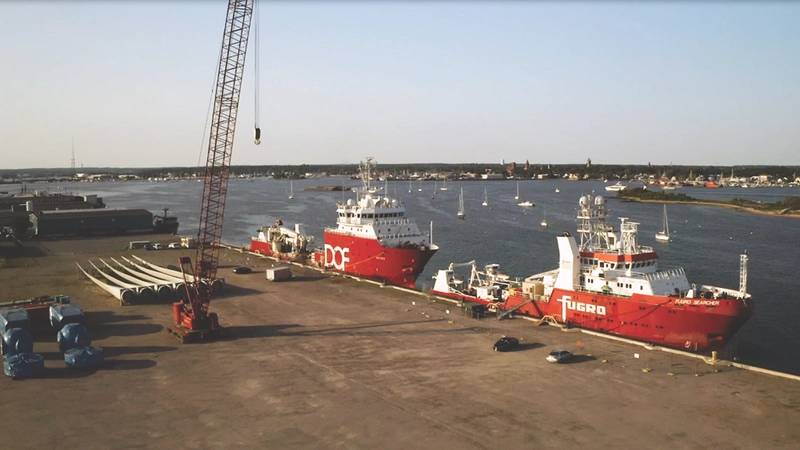 New Bedford, Mass. (Photo: Massachusetts Clean Energy Council)
New Bedford, Mass. (Photo: Massachusetts Clean Energy Council)The role of government, going beyond merely the investment component, will be vital. Crowley’s Roberts explained in prepared remarks at the Subcommittee hearing that “like the Europeans, America will need prudent government policies to jumpstart offshore wind development in this country. Regulatory measures needing attention include a more predictable permitting process; a possible regional approach to local content requirements; prompt Coast Guard regulatory actions related to the vessels required to install and service offshore wind turbines; and support and planning for the necessary port infrastructure.” In response to a query from newly elected Congressman Jake Auchincloss, representing a district in southeastern Massachusetts that includes Fall River, Roberts identified “a more predictable and responsive permitting system” as being the highest impact item in how the federal government might assist.
The human factor, identified by DNV’s Prokopuk as a hurdle to be overcome, will also play an important role in realizing the offshore wind ambitions, with the individual states crafting training initiatives. In February 2020, New York State’s NYSERDA announced that $20 million would be earmarked for a to-be-developed Offshore Wind Training Institute, at two Long Island branches of the State University of New York, for training approximately 2,500 workers. In 2019, the state of Massachusetts partnered with its maritime academy on a worker training initiative. Among its other workforce development platforms, a program for retraining fishermen to serve the offshore wind installations was unveiled, with an eye towards the Vineyard Wind project, with estimates of 3,500 jobs to be created. Down the coast in Virginia, Dominion Energy was negotiating with local unions, including electrical trades, for handling interconnections on the first phase of the offshore project, some 880 MW. One caution, however, came from OMSA, voicing concern that the earlier-mentioned hold on offshore oil and gas leasing might reduce the workforce to man vessels in the offshore service roles.
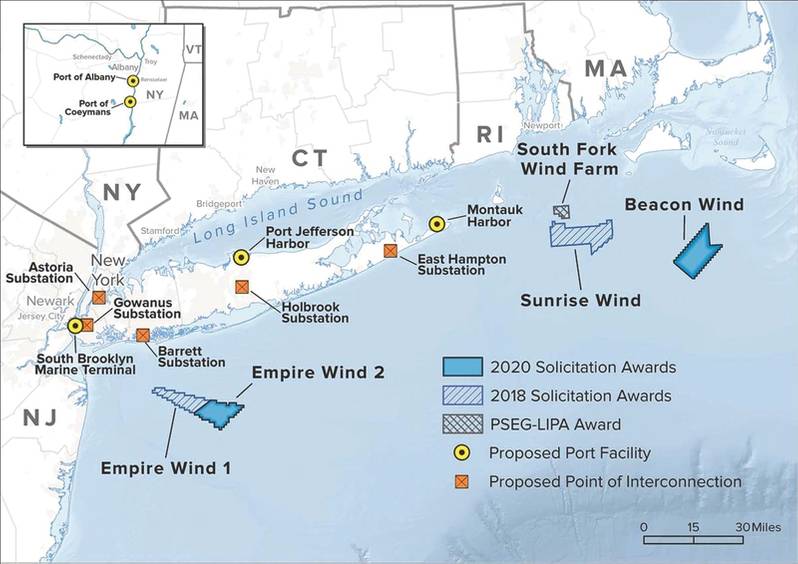 New York offshore wind projects (Image: NYSERDA)
New York offshore wind projects (Image: NYSERDA)The horizon is bright, but not free of clouds. Some observers have cautioned that the “local content” efforts that have driven the states to invest will need to morph over time into more regional supply chains. In the race to develop hubs, there will invariably be big winners, but also losers, where large capital investments will fail to pay off. New strains of NIMBY-ism and opposition tied to new types of business arrangements are also adding some color. While turbines from the South Fork Wind Farm—a 132 MW project, one of several to be developed by Ørsted and regional utility Eversource—will not be visible offshore, a row has erupted in the wealthy Hamptons enclave of Wainscott, on Long Island’s East End, over the underground routing of onshore electrical cables. To the north, in Connecticut, a dispute emerged in early 2020 between the City of New London and state authorities relating to the business arrangements, and property tax payments on the State Pier. Nearby, in New Bedford, Mass. (with a heavy-lift cargo terminal set to become a staging area for wind projects), local stakeholders are still striving for complementarity with the fishing industry.
-
- AMERICA'S SMALL- AND MEDIUM-SIZED YARDS REFERENCE GUIDE AND REVIEW Maritime Reporter, Aug 1990 #48
be completed by the fall. GLADDING-HEARN Circle 87 on Reader Service Card Located on the Tauton River across from the city of Fall River in Southeastern Massachusetts, Gladding-Hearn Shipbuilding is widely known for the construction and design of pilot boats, tugs, fishing boats and all-aluminum high-speed
-
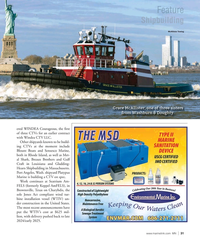 )
April 2024 - Marine News page: 31
)
April 2024 - Marine News page: 31McAllister Towing Grace McAllister, one of three sisters from Washburn & Doughty. ered WINDEA Courageous, the ? rst of three CTVs for an earlier contract with Windea CTV LLC. Other shipyards known to be build- ing CTVs at the moment include Blount Boats and Sensesco Marine, both in Rhode Island
-
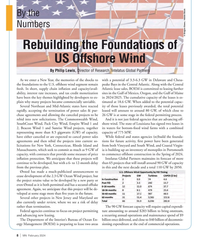 )
February 2024 - Marine News page: 8
)
February 2024 - Marine News page: 8By the Numbers © Dragon Claws / Adobe Stock Rebuilding the Foundations of US Offshore Wind By Philip Lewis, Director of Research, Intelatus Global Partners As we enter a New Year, the memories of the shocks to with a potential of 3.3-6.3 GW in Delaware and Chesa- the foundations to the U.S. offshore wind
-
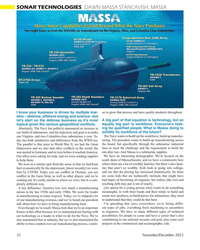 )
November 2023 - Marine Technology Reporter page: 32
)
November 2023 - Marine Technology Reporter page: 32SONAR TECHNOLOGIES DAWN MASSA STANCAVISH, MASSA ue to grow that process and have quality products throughout. I know your business is driven by multiple mar- kets – defense, offshore energy and science –but let’s start on the defense business as it’s most A big part of that equation is technology
-
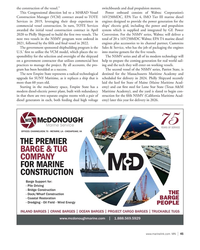 )
November 2023 - Marine News page: 45
)
November 2023 - Marine News page: 45the construction of the vessel.” switchboards and dual propulsion motors. This Congressional direction led to a MARAD Vessel Power onboard consists of Wabtec Corporation’s Construction Manager (VCM) contract award to TOTE 16V250MDC, EPA Tier 4, IMO Tier III marine diesel Services in 2019, leveraging
-
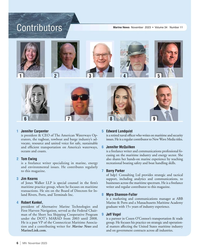 )
November 2023 - Marine News page: 6
)
November 2023 - Marine News page: 6Marine News November 2023 • Volume 34 Number 11 Contributors 1 24 35 7 6 8 9 1 Jennifer Carpenter 5 Edward Lundquist is president & CEO of The American Waterways Op- is a retired naval of? cer who writes on maritime and security erators, the tugboat, towboat and barge industry’s ad- issues.
-
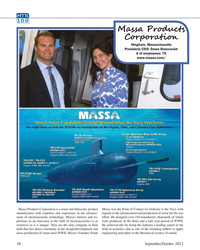 )
September 2023 - Marine Technology Reporter page: 38
)
September 2023 - Marine Technology Reporter page: 38MTR 100 Massa Products Corporation Hingham, Massachusetts President/CEO: Dawn Stancavish # of employees: 75 www.massa.com/ Massa Products Corporation is a sonar and ultrasonic product Massa was the Point of Contact for Industry to the Navy with manufacturer with expertise and experience in the advance-
-
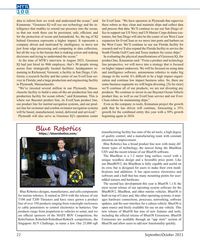 )
September 2023 - Marine Technology Reporter page: 22
)
September 2023 - Marine Technology Reporter page: 22MTR 100 data to inform how we work and understand the ocean,” said for EverClean. “We have operators in Plymouth that supervise Kinnaman. “Greensea IQ will use our technology and the in- these robots as they clean and maintain ships and collect data telligence that enables to extend our presence into the
-
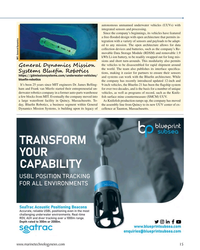 )
September 2023 - Marine Technology Reporter page: 15
)
September 2023 - Marine Technology Reporter page: 15autonomous unmanned underwater vehicles (UUVs) with integrated sensors and processing. Since the company’s beginnings, its vehicles have featured a free-? ooded design with open architecture that permits in- tegration with a variety of sensors and payloads to be adapt- ed to any mission. The open architect
-
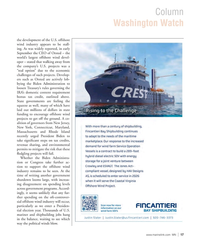 )
October 2023 - Marine News page: 17
)
October 2023 - Marine News page: 17Column Washington Watch the development of the U.S. offshore wind industry appears to be stall- ing. As was widely reported, in early September the CEO of Orsted – the world’s largest offshore wind devel- oper – stated that walking away from the company’s U.S. projects was a “real option” due to the
-
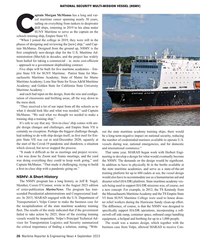 )
September 2023 - Maritime Reporter and Engineering News page: 26
)
September 2023 - Maritime Reporter and Engineering News page: 26NATIONAL SECURITY MULTI-MISSION VESSEL (NSMV) aptain Morgan McManus has a long and var- ied maritime career spanning nearly 30 years, sailing on everything from tankers to deepwater drill ships, returning in 2019 to his alma mater CSUNY Maritime to serve as the captain on the schools training ship
-
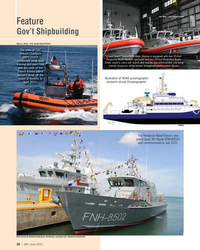 )
June 2023 - Marine News page: 30
)
June 2023 - Marine News page: 30small boat Small, used to carry out search and rescue, law enforcement and living training and exercises marine resources enforcement throughout southeastern Alaska. with the crew of the French ? shery patrol vessel Fulmar off the Illustration of NOAA oceanographic coast of Boston, in research vessel
-
 )
August 2023 - Marine News page: 16
)
August 2023 - Marine News page: 16Column Washington Watch NSMV: The Model of Future of Government Shipbuilding By Jeff R. Vogel, Member, Cozen O’Connor At the time of publication, Department of Transportation’s Volpe Center to make the the ? rst National Security Multi-Mission Vessel (NSMV), business case for the recapitalization of
-
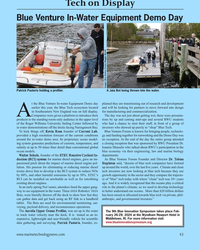 )
July 2023 - Marine Technology Reporter page: 43
)
July 2023 - Marine Technology Reporter page: 43out of research and development earlier this year, the Blue Tech ecosystem located and will be looking for partners to move forward into design in Southeastern New England was on full display. for manufacturing and commercialization. ACompanies were given a platform to introduce their The day was not
-
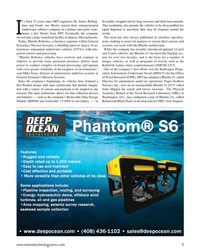 )
May 2023 - Marine Technology Reporter page: 9
)
May 2023 - Marine Technology Reporter page: 9t’s been 25 years since MIT engineers Dr. James Belling- be readily swapped out for long missions and short turn-arounds. ham and Frank van Mierlo started their entrepreneurial That modularity also permits the vehicles to be disassembled for underwater robotics company in a former auto-parts ware- rapid
-
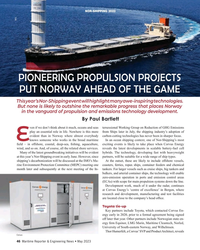 )
May 2023 - Maritime Reporter and Engineering News page: 46
)
May 2023 - Maritime Reporter and Engineering News page: 46NOR-SHIPPING 2023 MOL PIONEERING PROPULSION PROJECTS PUT NORWAY AHEAD OF THE GAME This year’s Nor-Shipping event will highlight many awe-inspiring technologies. But none is likely to outshine the remarkable progress that places Norway in the vanguard of propulsion and emissions technology development.
-
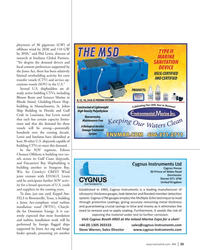 )
April 2023 - Marine News page: 33
)
April 2023 - Marine News page: 33ployment of 30 gigawatts (GW) of offshore wind by 2030 and 110 GW by 2050,” said Phil Lewis, director of research at Intelatus Global Partners. “Yet despite the demand drivers and local content preferences supported by the Jones Act, there has been relatively limited newbuilding activity for crew
-
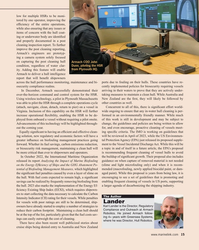 )
February 2023 - Maritime Reporter and Engineering News page: 15
)
February 2023 - Maritime Reporter and Engineering News page: 15low for multiple HSRs to be moni- tored by one operator, improving the ef? ciency of the entire operations, while also ensuring that any issues or items of concern with the hull coat- ing or underwater body are identi? ed and properly documented in a post cleaning inspection report. To further
-
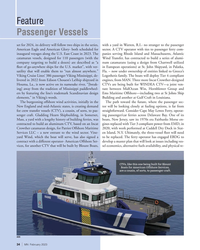 )
February 2023 - Marine News page: 34
)
February 2023 - Marine News page: 34Feature Passenger Vessels set for 2024, its delivery will follow two ships in the series, with a yard in Warren, R.I.- no stranger to the passenger American Eagle and American Glory- both scheduled for sector. A CTV operator with ties to passenger ferry com- inaugural voyages along the U.S. East Coast in
-
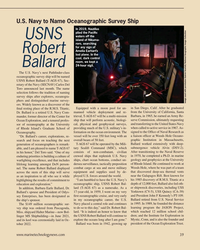 )
January 2023 - Marine Technology Reporter page: 39
)
January 2023 - Marine Technology Reporter page: 39U.S. Navy to Name Oceanographic Survey Ship In 2019, Nautilus plied the Paci? c waters off the USNS island of Nikuma- roro, searching for any sign of Amelia Earhart’s Robert lost plane. In the cool, dark control room, we kept a 24-hour vigil. Ballard The U.S. Navy’s next Path? nder-class
-
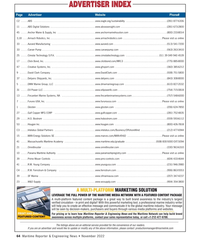 )
November 2022 - Maritime Reporter and Engineering News page: 64
)
November 2022 - Maritime Reporter and Engineering News page: 64Index page MRNov22R:MN INDEX PAGE 11/7/2022 4:07 PM Page 1 ADVERTISER INDEX Page Advertiser Website Phone# C2 . . . . .ABS . . . . . . . . . . . . . . . . . . . . . . . . . . . . . . . . . . . . . . . . . . . .www.eagle.org/sustainability
-
 )
November 2022 - Maritime Reporter and Engineering News page: 41
)
November 2022 - Maritime Reporter and Engineering News page: 41GRADUATE PROGRAMS MASSACHUSETTS MARITIME ACADEMY As certain fuels are banned (at least in emissions-control areas, or ECAs), the ability of FPPs to produce future fuels, like ammonia, might become “standard”. The Keppel deal M.S. Maritime Business Management includes an “aside” MOU with Mitsubishi Heavy
-
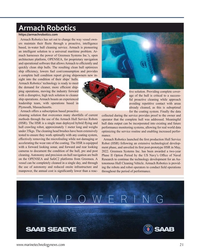 )
September 2022 - Marine Technology Reporter page: 21
)
September 2022 - Marine Technology Reporter page: 21Armach Robotics https://armachrobotics.com Armach Robotics has set out to change the way vessel own- ers maintain their ? eets through a proactive, intelligence based, in-water hull cleaning service. Armach is pioneering an intelligent solution to a universal maritime problem. Ar- mach harnesses the power
-
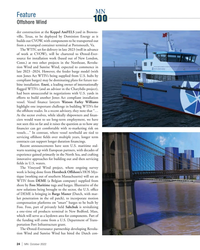 )
October 2022 - Marine News page: 24
)
October 2022 - Marine News page: 24MN Feature Offshore Wind der construction at the Keppel AmFELS yard in Browns- ville, Texas, to be deployed by Dominion Energy as it builds out CVOW, with components to be transported out from a revamped container terminal at Portsmouth, Va. The WTIV, set for delivery in late 2023 (well in advance of
-
 )
June 2022 - Maritime Reporter and Engineering News page: 64
)
June 2022 - Maritime Reporter and Engineering News page: 64Index page MRJune22_R:MN INDEX PAGE 6/6/2022 2:22 PM Page 1 ADVERTISER INDEX Page Advertiser Website Phone# C2 . . . . .ABS . . . . . . . . . . . . . . . . . . . . . . . . . . . . . . . . . . . . . . . . . . . .www.eagle.org/government .
